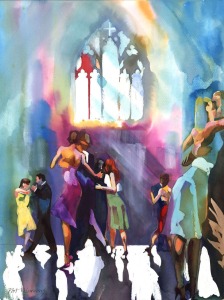My thoughts recently have turned to teaching beginners Argentine Tango at TLC in Southampton.

Afternoon Milonga by Pat Murray
In preparing for this I experienced an interesting case of synchronicity as I was reading a book by Massimo Scaligero called ‘The Secrets of Space and Time’. In this book Scaligero talks about ‘true’ movement, an idea that smacked me right in the forehead as I saw its relation to the essence of dance!
Most of the time we move normally without much thought. We think functionally: I want to pick this object up; I want to move my hand to here etc, and our bodies do this for us.
If you wish to truly understand just how much is automatic go and talk to someone with Parkinsons, a disease which afflicted by father. Even now I remember his tears as this once amazing dancer tried to will his body to do the simplest tasks.
During this unconscious movement our bodies move us. But there is a different form of movement where we can learn to be more conscious as WE move our bodies. The former is something we cannot take responsibility for, and cannot truly individually own. The latter is where we can truly express ourselves.
This second form of movement is not purely a physical phenomenon – it has its source in our thinking. True conscious movement is the physical expression of our Thinking – capital T.
Try the following exercise and you might just be able to experience how different this movement is from our normal unconscious mode:
1: Stand up in a space where you have room to stretch your arms straight above you without hitting any ceiling. Stand with you arms down your sides.
2: Raise your arms to the horizontal position as you would normally do – unconsciously, without giving it much thought. You might experience this as a pushing feeling. You should be able to feel that you do not own the movement, just its result.
3: Now return your hands to your sides and imagine that there are infinitely long threads (and I mean infinite!) extending straight out from the ends of your fingertips. Imagine that these threads are raising your hands as they pull outwards and upwards. With your thinking imagine how, as those strings traverse space, you are cutting the universe in half out from your centre to infinity. You may need to do this quite slowly and might experience it as more of a pulling feeling.
This takes conscious practice and requires a disciplined – yet relaxed – imagination. Properly done it will feel totally different to step 2. It will be as if your Thought is moving you, as if the body need do nothing but attend to the Thinking movement you are trying to realize.
This is the essence of the movement of a good dancer
They will be centred in themselves.
They will be poised in space.
They will seem to move with a graceful lack of effort.
They are doing nothing less than touching the infinite with their own Thinking movement as it expresses their individuality into their bodily movement.
They will be collapsing that infinitude to a singularity in their thought and thus, given the relationship between time and space, they can bring us to a timeless point of awareness. According to Scaligero this is the true awareness of space and time and it will take some practice.

Tango dancers sketch by Pat Murray
Bringing this back to dance, and Argentine Tango in particular where we learn to consciously walk with a partner, it is noticeable how difficult it is to re-learn something we normally unconsciously do. In this case something we learnt in our formative toddler years before our ‘I’ became present (usually around 3 years old).
If we can individually achieve this consciousness and attention it can be very enlightening and life enhancing.
If we can do this with our dance partner then it becomes a truly creative, artistic and sublime experience.
Happy dancing!

